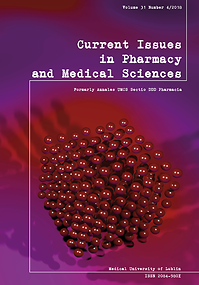New Drugs - From Necessity to Delivery
DOI:
https://doi.org/10.1515/cipms-2018-0020Keywords:
drug development, drug design, lead compound, preclinical trials, clinical trialsAbstract
How to get a new drug to market? How much time does it take to go from the idea to implementation? In this study we followed the path drugs take from synthesis to introduction to the market. In doing so, articles in the PubMed and the Google Scholar database have been analyzed using the keywords: drug development, drug design, lead compound, preclinical trials, clinical trials. The available literature was subjectively selected due to its usefulness in the topic. Based on the obtained articles, we presented the stages that a would-be drug takes on the way from the idea to marketing. Herein, it is underlined that the process of creating new drugs is long, extremely labor-intensive, and involves many restrictions in the context of the use of animals, as well as humans.
References
1. Schultes RE. The appeal of peyote (Lophophora williamsii) as a medicine. Am Anthropol. 1938;4:698-715.
2. Scarborough J. Drugs and medicines in the roman world. Expedition. 1996:38-51.
3. Patrick GL. An Introduction to Medicinal Chemistry. Wyd. 5. Oxford University Press; 2013.
4. Zając M, Pawełczyk E, Jelińska A. Chemia leków dla studentów farmacji i farmaceutów. Wyd. 2. UM Poznań; 2006.
5. Mutschler E, Geisslinger G, Kroemer HK, Ruth P, Schaefer-Korting M. Farmakologia i toksykologia. Wyd. 3. Wrocław: Elsevier; 2012.
6. Silverman RB. Chemia organiczna w projektowaniu leków. Warszawa: Wydawnictwo Naukowo-Techniczne; 2004.
7. Ghofrani HA, Osterloh IH, Grimminger F. Sildenafil: from angina to erectile dysfunction to pulmonary hypertension and beyond. Nat Rev Drug Discov. 2006;5:689-702.
8. Matosiuk D, Fidecka S, Antkiewicz-Michaluk L, Dybala I, Koziol AE. Synthesis and pharmacological activity of new carbonyl derivatives of 1-aryl-2-iminoimidazolidine. Part 3. Synthesis and pharmacological activity of 1-aryl-5,6(1H)dioxo-2,3-dihydroimidazo [1,2-a]imidazoles. Eur J Med Chem. 2002;37:845-53.
9. Altshuler D, Daly MJ, Lander ES. Genetic mapping in human disease. Science, 2008;322:881-8.
10. Bodera P, Chcialowski A. Immunomodulatory effect of probiotic bacteria. Recent Pat Inflamm Allergy Drug Discov. 2009;3:58-64.
11. Willson TM, Brown PJ, Sternbach DD, Henke BR. The PPARs: from orphan receptors to drug discoveryJ Med Chem. 2000;43:527-50.
12. Shi Y. Orphan nuclear receptors in drug discovery. Drug Discov Today. 2012;12:440-45.
13. Chin YW, Balunas MJ, Chai HB, Kinghorn AD. Drug discovery from natural sources. AAPS J. 2006;8:E239-E253.
14. Zucker KA, Adrian TE, Zdon MJ, Ballantyne GH, Modlin IM. Asperlicin: a unique nonpeptide cholecystokinin antagonist. Surgery. 1987;102:163-70.
15. Fitch RW, Spande TF, Garraffo HM, Yeh HJ, Daly JW. Phantasmidine: an epibatidine congener from the Ecuadorian poison frog Epipedobates anthonyi. J Nat Prod. 2010;73:331-7.
16. Kostis JB. Angiotensin converting enzyme inhibitors. I. Pharmacology. Am Heart J. 1988;116:1580-91.
17. Hollis A. Me-too drugs: is there a problem. WHO report. 2004.
18. Drews J. Drug discovery: a historical perspective. Science. 2000;287: 1960-64.
19. Warne T, Moukhametzianov R, Baker JG, Nehmé R, Edwards PC, Leslie AG et al. The structural basis for agonist and partial agonist action on a β 1-adrenergic receptor. Nature. 2011;469:241.
20. Plunkett MJ, Ellman JA. Chemia kombinatoryczna i nowe leki. Świat Nauki. 1997;6:26-31.
21. Cherkasov A, Muratov EN, Fourches D, Varnek A, Baskin II, Cronin M et al. QSAR modeling: where have you been? Where are you going to? J Med Chem. 2014;57:4977-5010.
22. Polak S, Wiśniowska B. Modelowanie komputerowe w badaniach nad lekiem – projektowanie i poszukiwanie cząstki aktywnej, ocena właściwości fizykochemicznych oraz aktywności biologicznej. Farm Pol. 2009;65:214-23.
23. Gruca A. Bioinformatyczne bazy danych. Warszawa: Wydawnictwo Polsko-Japońskiej Akademii Technik Komputerowych; 2010.
24. Berlicki L, Kafarski P. Computer-aided analysis and design of phosphonic and phosphinic enzyme inhibitors as potential drugs and agrochemicals. Curr Org Chem. 2005;9:1829-50.
25. Vogel G. Phylogenetic analysis: getting its day in court. Science. 1997;275:1559-60.
26. Honek, J. Preclinical research in drug development. Medical Writing. 2017;26:5-8.
27. Seńczuk W. Toksykologia współczesna. Warszawa: Państwowy Zakład Wydawnictw Lekarskich; 2012.
28. Russell WMS, Burch RL. The Principles of Humane Experimental Technique. London: Methuen & Co. Special edition published by Universities Federation for Animal Welfare (UFAW);1992.
29. Schollenberger A. Zasada 3R w ochronie zwierząt wykorzystywanych do badań naukowych. Życie Weterynaryjne. 2017;92.
30. Rusche B. The 3Rs and animal welfare-conflict or the way forward. Altex. 2003;20:63-76.
31. Dodd A, Curtis PM, Williams LC, Love DR. Zebrafish: bridging the gap between development and disease. Hum Mol Genet. 2000;9:2443-9.
32. Zon LI, Peterson RT. In vivo drug discovery in the zebrafish. Nat Rev Drug Discov. 2005;4:35-44.
33. Lieschke G, Currie PD. Animal models of human disease: zebrafish swim into view. Nat Rev Genet. 2007;8:353-67.
34. Howe K, Clark MD, Torroja CF, Torrance J, Berthelot C, Muffato M et al. The zebrafish reference genome sequence and its relationship to the human genome. Nature. 2013;496:498-503.
35. Pandey BU, Nichols CD. Human disease models in Drosophila melanogaster and the role of the fly in therapeutic drug discovery. Pharmacol Rev. 2011;63:411-36.
36. Brodniewicz T. Badania kliniczne. Wyd 1. Warszawa. CeDeWu. 2015.
37. Jachowicz R. Farmacja praktyczna. Warszawa: Państwowy Zakład Wydawnictw Lekarskich; 2007.
38. Mahan V. Clinical trial phases. Int J Clin Med. 2014;5:1374-83.
39. National Centre for the Replacement, Refinement and Reduction of Animals in Research. https://www.nc3rs.org.uk/the-3rs (stan z 01.03.2018).
40. Portal Farmaceutyczno-Medyczny. Patent na lek. https://www.pfm.pl/artykuly/patent-na-lek/275 (stan z 01.03.2018).
Downloads
Published
Issue
Section
License
Copyright (c) 2018 Authors

This work is licensed under a Creative Commons Attribution-NonCommercial-NoDerivatives 3.0 Unported License.


